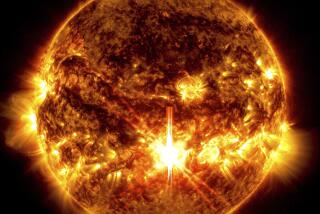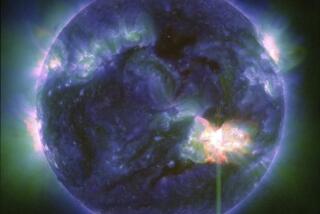‘Extreme’ solar flare erupts, looks like storm is headed to Earth
A heavy-duty solar flare erupted on the surface of the sun midmorning Thursday, and it appeared from early data that a solar storm from the X-class eruption was headed toward Earth.
“It looks to be headed in the Earth’s direction,” Alex Young of Maryland’s Goddard Space Flight Center told the Los Angeles Times in an interview Thursday. But, he noted, that’s based on a view from just one of two spacecraft monitoring the sun.
The so-called coronal mass ejection -- a violently released bubble of gas and magnetic fields -- could veer off. Scientists are waiting on more data from spacecraft within the next few hours to pinpoint the speed and severity of the storm.
Mike Hapgood, a space weather scientist at the Rutherford Appleton Laboratory near Oxford, England, explained coronal mass ejections in a recent interview with The Times:
“Coronal mass ejections are caused when the magnetic field in the sun’s atmosphere gets disrupted and then the plasma, the sun’s hot ionized gas, erupts and send charged particles into space. Think of it like a hurricane — is it headed toward us or not headed toward us? If we’re lucky, it misses us.”
The size of the flare is a “reasonable” indicator of the strength and speed of a coronal mass ejection, Young said. Thursday’s flare was categorized at X1.4. Among the categories of flares, according to Young, are C, M and X -- which, in general, translate to common, moderate and extreme.
The ejection, traveling at speeds of 1 million to 5 million miles per hour, takes about one to three days to reach Earth, said Young, associate director for science for the heliophysics division at Goddard Space Flight Center in Greenbelt, Md.
Solar eruptions like these pose a danger to Earth’s technology, as well as any spacecraft and astronauts that lie in their way.
The blast of electromagnetic radiation can cause radio blackouts, Young said, and, in more extreme cases disrupt power.
More and stronger space weather events are likely headed our way in coming days, the scientist said. The sun is nearing a peak in the solar activity cycle.
“Solar activity has a cycle, minimum to maximum to minimum, and it’s getting close to the peak of solar maximum,” he said, which will occur sometime in 2013 or 2014. It’s a cycle of about 11 years.
Hapgood described some of the consequences of a massive solar storm. With power disrupted, the pumps that bring water into homes and pump the sewage away could stall; transportation could grind to a halt without the ability to pump fuel into vehicles; without power, ATMs and credit card machines would freeze up.
Young noted, however, that the likelihood of space weather causing catastrophic problems on Earth was very slim. Solar flares erupt regularly, spewing matter in all directions, usually missing Earth altogether. And power companies and other entities affected by space weather do prepare for possible problems.
“Space weather can have very strong effects on our technology,” he said, but it’s like living in an earthquake zone or near where hurricanes occur. “You prepare for them, but most people don’t spend their day worrying about it.”
ALSO:
What is Scientology? One adherent explains
Sandusky abuse case: Freeh report condemns Paterno, others
Anonymous? Judge demands name of newspaper’s online commenter
More to Read
Sign up for Essential California
The most important California stories and recommendations in your inbox every morning.
You may occasionally receive promotional content from the Los Angeles Times.











